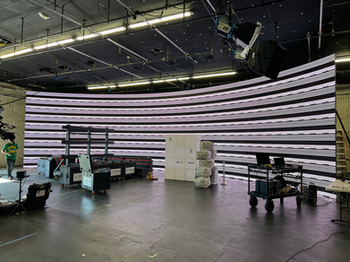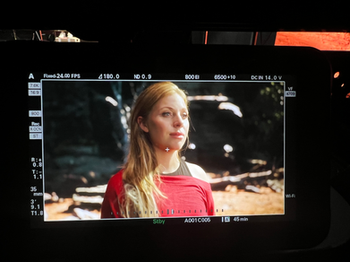
2022 is almost over, and we wanted to take an opportunity to recap the highlights of our most fun demonstration this year: the Virtual Production Summit hosted by Microsoft, Nvidia and Epic Games! This first-time event was a huge success and brought together some of the best in the industry to share and play together in a space ripe with innovation.
Catalyst was invited by show partners CG Pro and Brandstar to design a demo that would showcase a full-on Virtual Production in front of an audience, allowing them to see the process of filming on an LED wall stage with a small crew and remote artists. The onset Virtual Production operation was supplied by VP Toolkit & Brandstar. Together our main goal was to update the audience - and ourselves - on just how far Virtual Production capabilities have come in the past few years.
When we think about virtual production, often we focus on the positive benefits to the physical production itself - like how locations can be manipulated faster, or reflective surfaces looking more realistic. However, the possibilities don’t end there, and a lot of exciting developments are right on the horizon. When your location and set exist in a virtual world, people and resources from across the globe can be brought in to an on-set ecosystem, and unlock powerful collaboration possibilities beyond anything we’ve yet to experience as content creators.
Catalyzing the Cloud
We often get questions about how the cloud can be utilized in ICVFX. Catalyst already implements a custom platform for our clients that containerizes existing core Virtual Production components, and virtualizes rendering & editor nodes. Microsoft gave us access to the Azure network complete with the Nvidia's latest Tesla V100 GPU-accelerated VMs to use as remote workstations. With these capabilities and the support of Microsoft’s Partner Program at our back, we went to work translating our existing solutions to the cloud ⛈️.
6 days ‘till showtime!

One day and a night of no sleep later, we had the basic collaboration services of Perforce, Multi-user and VPN spun up and accessible to our remote artists. With that, our Level Artist was able to push the Unreal level for the demo to Perforce. In combination with the multi-user server, Director Erik "Wolfie" Wolford and his team were able to help our artists lock in lighting setups in pre-pro along with setting stage locations with the VP Toolkit plugin. All of these participants were able to use GPU accelerated VMs - complete with Unreal Engine installed to view and edit the scene from any internet-connected computer in the world.

Once our wall and render nodes were deployed in Los Angeles, an isolated network with a dedicated router was set up to tie them all together. A well-configured isolated network is critical for the smooth operation of a real-time ICVFX shoot, in any context. However, by using a modern router with the ability to run a Wireguard VPN client natively, we can bridge the entire network of computers to our cloud network through this one appliance.

To fully demonstrate this principle, we connected Catalyst headquarters in Philadelphia to the VPN environment using it’s own gateway, giving the LA stage access to our internal file shares and development resources immediately. This simulated the concept of an existing studio’s on-premises resources being connected seamlessly with a remote stage.
This hybrid approach to a virtual production infrastructure offers the best of both worlds - on-set resources remain on set, and the stage will operate as it normally does (without remote editors) if the internet happens to go down. However, the likelihood of that happening these days over a power failure or some other kind of technical issue is probably higher! One can also bring along a contingency plan, such as a mobile hotspot.
Some aspects of Virtual Production, such as the high-bandwidth and low-latency requirements for nDisplay renders, can’t be translated to the cloud quite yet. Regardless, linking remote collaboration resources to an on-set infrastructure via a well configured network opens up limitless collaboration possibilities, without introducing extra variables that could affect production performance.

Bringing it Home
On location we collaborated with VP Toolkit founder and Virtual Production Supervisor (co-founder of Catalyst) Ian Fursa to handle the onsite Unreal Production Operation and nDisplay configuration.

During the production demo, we went through the flow of being on an actual Led Wall ICVFX Virtual Production and filmed a short skit that was written by CG Pro. Moving from shot to shot, director of photography for the event Wofie exposed common camera and lighting techniques for troubleshooting the issues that occasionally plague ICVFX. VP Toolkit demonstrated their new UE 5 plugin’s capabilities to easily switch to different Unreal Level Locations and Frustum Camera Configurations. Taking us from different setups with the speed and reliability that we needed to pull off an entire production within an hour of presentation.
With unreal engines new Nanite and Lumen features our onset and remote operators were able to change the lighting and virtual set design without any light baking down time. What a sight it was to have remote operators from Japan and Argentina helping with the scene lighting and prop design while taking direction from our remote Director and onset Director of Photography. Using VP Toolkit and Unreal Engine’s features like sequencer, level snapshots & location marker system even a remote operator could recall lighting and virtual stage placement within seconds.
It really is a new era for virtual filmmaking. On to the next innovative Virtual Production!
Live Demo Crew
Ian Fursa - VP Toolkit / Catalyst
Virtual Production Supervisor
Steve Chandler - Catalyst VP
Infrastructure Architect, Co-Founder
Erick Geisler - To Whom It May Concern...
Director / Producer, Creative Director
Edward Dawson-Taylor - CG Pro
Co-Founder, Head of School
Jacqueline Cooper - Director (CG Pro)
Co-Founder and Head of Community and Placement
Erik "Wolfie" Wolford - Cinematographer
Speaker
Gabriel Paiva - Remote Artist (CG Pro)
Speaker and Instructor
Stephen Wilcox - Remote Artist
www.productionsummitla.com | www.vp-toolkit.com | www.becomecgpro.com















